PHOTOS BY NICK D FOR PRECURSORPRINTS.COM
INTERPRETED BY JIN TAO
SPECIAL THANKS TO ELEMENTS MALL
说实话,我受邀采访Nick Cave的时候,着实大吃一惊?音乐家Nick Cave吗?不,不,是另一位同名艺术家。我说的也不是那位Nick Cave身边的第二小提琴手。Nick Cave刻画了属于他自己不同凡响的名字。谷歌一下他的SoundSuits,一定会令你印象深刻,亲眼目睹的话会更加震撼。与这样一位和蔼可亲,充满了活力与恶作剧精神的Nick在香港见面交谈,真可谓是幸事一件。不仅仅是艺术,还有身份,种族,教育和精神都在这能够在这次的谈话中窥知一二。我们使尽浑身解数,对面前这位绅士的大脑进行了一次有趣的探索。
Honestly when I was invited to interview Nick Cave, I was like what? Nick Cave the musician? No, no, the other Nick Cave, the artist. Not that he plays second fiddle to the musician either. Nick Cave has carved out his own name. Google his soundsuits, they are impressive. Even more impressive moving and in person. An affable man, full of energy, and mischief, it was great to have the opportunity to sit down, and speak to Nick in Hong Kong. To talk about art and much more. Identity, race, education, and spirit all make an appearance in this conversation. Nary a stone was left unturned, as we picked this man’s brain in a thoroughly enjoyable conversation.
< English continued after the Chinese >
SPITGAN – Nick Cave先生,这是你第一次来亚洲,香港吗?
Nick Cave – 尼克洞 – 是的。
SG – 你感觉如何?
NC – 很棒。我已经四处逛过了。这一点很重要,我在旅行中,都会出去走走,感知一下这是一座怎样的都市,这就是所谓的精神食粮。
SG – 我在关于你的报道中听说过。那你有没有什么发现?什么新素材呢?
NC – 不见得。你会讶异为什么这里的一切都变得一摸一样,这实在是有点可惜。你想在这里看到未经改造过的原汁原味的东西,然而却被消费者掩埋了。我想这是一个消费驱动的都市,给我的感觉非常激烈。我从未去过任何一个地方,是被购物商场所环抱的。我甚至都不走进商场,我也不会在商场逛太久的。(众人皆笑)不仅如此,商品也是相当丰富!到处都被霓虹覆盖,我喜欢这种疯狂。
SG – 我觉得这里的商场,不仅仅是购物商场。我认为人们能从中获得基本讯息,并在其中发挥着各自的作用。就像小型城市一样。
NC – 感觉这里的商场上方俨然已成为一个社区。所以,你会在这工作,生活,购物。你去了那儿,就不会来这儿,也不会去别的地方。它就像众多口袋一般孤立存在着,并无太多乐趣。
SG – 有时商场之上的确是住宅楼。
NC – 是的,我发现了。它改变了我们的生活方式。在世界中,在我们自己的城市中。
SG – 通过旅行我认识到了全球化,很多事物都变得很接近,许多现代文化破坏了传统文化。为了能够建立新的,他们摧毁了传统的。
NC – 额。这的确令人沮丧。
SG – 这是你首次在这种商业空间内呈现你的作品吗? (Nick Cave的Soundsuit在香港圆方商场展示。)
NC – 是的,这是第一次。
SG – 是否存在挑战或分歧?
NC – 嗯……没有。对我来说,这类的表演,被设置在了人流汇集的地方…这很重要,因为我觉得有些……世界上绝大部分人不会频繁光顾博物馆,没有获得足够的文化补给。那么,我们作为艺术家,该如何寻找到我们的方式来渗入他们的日常活动中。
SG – 以前听说过这件作品,不是第一次被展示了吧?是否能谈谈灵感来源呢?
NC – 该作品的灵感……我获得了这个项目以及演出的机会,所以我想应该如何来呈现?于是我开始思索我们如何存于这个世上。我们的梦想越来越少,我们也不再以幻想的方式考虑问题。我们的全身心被工作,工作保障所消耗。所以,我们在寻觅…该如何在世界中运作,铺设出自己的道路。这让我以一个孩子的角度开始思考;孩子会用一张纸一个盒子做出一匹马,你再把耳朵剪掉。就是这样。在那一刻,奇迹发生了!也就是美之所在!虽如此简单,但影响却又如此巨大。我真的想过这个问题,我能在公共领域做些什么,人们从A点移动到B点,或许能够在他们的运行轨迹上令他们停驻一两分钟。想想我们的运作模式吧,我们从不曾停驻脚步哪怕一秒。我们一直在世界中移动。我们已经忘了什么是重要的!那就是体验,为你所呈现的那一刻。
SG – 说的很对。
NC – 所以灵感也就是这么来的。首先我是一位信使,然后才是艺术家,这只是我的一点心意。
SG – 什么样的信使…
NC – 我不知道,但这就是我。我真得不知道该怎么定义,但我就是知道。
SG – 你首次演出是在纽约中央车站。是否有与观众互动呢?
NC – 我只是在中央车站和这个作品有一些互动,一天演了两场。
SG – 不过观众应该相当靠近……
NC – 当时观众是被限制在表演区外的。
SG – 原来如此,我想问你,这是不是第一次,观众以某种方式成为作品的一部分?
NC – 他们并未成为作品的一部分,也不能成为一部分,那样太疯狂了。疯狂! HAHAH。在纽约它的确很疯狂。
SG – 是的。甚至当我拍照的时候,它就突然出现在我面前了。
NC – 是的。这只是其中一部分。挺有趣的。 HAHAH。 (软弱无辜的声音。)
SG – 你与Elements或者委托人合作制定了表演空间的方案吗?
NC – 是Elements邀请我在这打造这个作品…
SG – 是布景…
NC – 不是布景。(布景是一个圆形平台上的一个庆祝马年的硕大马脑袋)
SG – 马年有什么希望和计划吗?
NC – 我的希望和计划?繁荣……这是我的念头。
SG – 繁荣是一个非常亚洲的词汇!
NC – 是的!我知道!对我来说,这个项目的目标是周游世界,也正在实现中。这期间我正在打造项目6。所以,我只是跳上飞机去我需要去的地方。
SG – 你工作速度快吗?或者说过程快吗?
NC – 是的,很快。
SG – 回到你的教育背景,堪萨斯艺术学院是如何塑造你的艺术观呢?
NC – 堪萨斯艺术学院是一所非常私人化学校,像一座城市里的一幢房子。你被无所畏惧的人所环绕这,就好比’把它带上来’,一针见血,真是挺刺激的。在那种环境中所感受到的每个人的感情就是志在必得!那就是我的成长经历,和教育背景。先是那里,然后又是Cranbrook(美术学院),它的校园太伟大了。
SG – 请描述一下。
NC – 同样的,是一所私立学校,出类拔萃的私立学校。那是一个世界,身在其中便会以一种特殊的方式在艺术世界与该文化中取得成功。这意味着,决定权在自己手中!
SG – 那堪萨斯城的文化氛围在你学习期间又是怎样的呢?
NC – 如今与我当年在读期间已经大不相同了。我觉得我们那时更自由。
SG – 更自由?
NC – 更自由……那是上世纪70年代…每个人都是那样,现变得保守了。
SG – 能具体点吗?
NC – 如今的学生就是这样。我们那时的学生更善于表现。
SG – 是不是因为当年被鼓励表现?是一种教学方式吗?
NC – 不,我并不这么认为。我认为这依赖于气氛。你仔细想想我们不同的手法?今日的运动者与当年的有何不同。不同于以往,一切都非常精确与限制,都在界限和规则之内。就像我们即将关闭Lakeshore Drive。这里就像你去A街上,转个弯,大家都聚在那儿。
SG – 对,就像一种日常路线!
NC – 你可能会认为因为社交媒体,如今会比较激烈,但其实它只是不一样了。我不认为这些是原因。令人沮丧。
SG – 当今人能更快捷地获得大量信息,这是否会令人变得更保守?
NC – 我不知道。我觉得我们都太安于现状,而不知进取。
SG – 没错。
NC – 我觉得很多东西都已经改变了。我认为种族主义也不同于以往。而今是比较被动的。
SG – 能具体说明一下吗…
NC – 我说的不是你上了公交车必须坐在后排,你懂的 ,现在人的宽容度…
SG – 但它是存在的!非常强烈的存在!
NC – 是,当然存在!非常强大如你所说!这个该死的话题够说上一整年了!
SG – 但我认为存在着某种相关性。你看美国,再看中国……这是一种现状。亟待解决的现状。
NC – …我碰到太多这样的情况了。
SG – 正如你说的它改变了形态与脸孔。
NC – 你一定非常非常清楚那是怎样的。
SG – 嗯,回到你的教育背景。你是否在那里就萌生了关于身份的想法的对话,因为曾读到这是你的主题之一…
NC – 我觉得应该是我去了Cranbrook读硕士后,才碰到了身份的问题。因为我走进了某个环境,突然间,我成了唯一的黑人学生!我感到很乱,我甚至无法面对!所以,我是从那个时候起开始面对身份的问题,因为以前我真得没有遇到过需要面对这个问题的环境。我被扔到了一种境遇里,我当时想,哦,我的上帝,这是真的吗?感谢上帝创造了底特律!像Cranbrook在底特律的郊区。感谢底特律!因为我不知道我是否能够存活下来!我去了底特律就像… 松了一口气一样。
SG – 被淹没了?哇。
NC – 是的。
SG – 那时底特律正在不断改善?
NC – 感觉那里时好时坏…
SG – 喔。但你知道底特律的音乐历史十分强大!
NC – 底特律!音乐和文化真是历经了不少风雨,但它似乎总能回到正确的轨迹。
SG – 我同意。你所关心的是怎样的身份?是自我认同?或是更具包容性? 非单一的?寻找表达这些想法的艺术手段是否具有挑战性?
NC – 我认为它代表更独立。我所关心的……是如何离真相更近,是你做真正的自己。相对于顺从,或条件反射地行为,或看,或特定的行为方式。它贯穿我的作品,这也可能是我作品中的主要潜在因素。
SG – 您也曾跟以为有名的绅士学习过舞蹈,Alvin Ailey?你见过他吗?
NC – 不,他已经去世了,我见过他。但其实是Alvin Haley,还有Judith Jameson……我继承以及传递了他们的财富。但我学习舞蹈并不是为了学习舞蹈。我学舞蹈艺术是考虑到它是一个艺术媒介。这就是我一贯的方式。
SG – 你有一个硕士学位。你觉得这种教育体系和自我完善是否重要?教育整体是否重要?
NC – 很不幸,我的确这样认为。我们都在这种体系下长大的。没了它我能成为今天的我吗?也许吧。但它还是很重要的!
SG – 因为艺术不像金融或者别的领域的东西。
NC – 我在芝加哥艺术学院任教,我们不给分数。只有及格或不及格。那么,教育是否(怎样)发挥它的作用呢?我觉得教育提供了你与同龄人的环境。我认为,从历史,人文角度来看,它发挥了伟大的作用。
SG – 在创造第一个soundsuit之前,你在做什么呢?
NC – 我做了大量建设性的绘画。有8×16平方英尺!由墙面延伸至地面。
SG – 哇。
NC – 其实也是我的研究生课题。我只是又探索回去了!昨天我还在想呢!我的下一场秀,我要做一副墙上开始的画作……我称它为一幅画,但它配合了soundsuit制作出来。由墙面延伸至地面。
SG – 好极了!
NC – 我真不觉得我在“这是我的事业”中是与众不同的。我的下个个展9月在纽约举办。与soundsuits没半点关系。它倾向于雕塑作品,以及视频。它是政治,与soundsuit无关。
SG – 第一个soundsuit由Rodney King的悲惨事件触发。思路是否由保护和武装而来呢?它看起来就像是……树枝……
NC – 首先我将它看作是一个雕塑,并不知道能够穿在身上。接着我穿上它,并在里面移动,我开始思考关于抗议的事。为了传达自己的声音,你必须大声说话,必须更主动出击。然后,我开始思考的恐惧的边缘。对我,一个非洲裔男性来说,如何感知,都是主观的,可同时我们又被恐惧所吸引……总之,它是许多奇怪思考方式的集合体。
SG – 你之后做的soundsuits带入了更多积极的情绪?你的调色板看上去更加充满活力。
NC – 不完全是……活力总在变化。我作为一个艺术家第一以及首先要考虑的是,‘我怎么画我的观众’。即便是表面色彩纷呈,可能内在还是非常灰暗的。
SG – 和其他艺术家的合作表演的想法,我也问过William Bell,我也看过你的表演视频。你似乎很放得开,很乐意合作。
NC – 当我合作时,是这样的。我走到门口,进了门以后就把自我挂到架子上,然后我潜入那个空间。但是!如果是我的项目,我会以松散的方式探索我想要表达的主题,对我的合作是一个很大的草图。艺术也是如此。有没有真正的结局以及结论。
SG – 我认为这很新鲜。我在西雅图看到你的一部视频。你邀请观众上台,然后说到要让每次演出都是独一无二的。所以你坚持让每次演出都不一样。
NC – 是不一样的。比方说,你可能那一晚刚同女友分手。这样,第二晚的演出就不会跟之前一样。或者家里有不幸发生,又或者谁知道?你只是没TMD感受到!
William Bell – 实话!
NC – 所以重点是如何互相扶持面对各种局面并应付自如。
SG – 我也认为这很新鲜,可能因为现况窘迫,一切都是那么一板一眼。你必须怎么怎么做!你必须3点30分关门…
NC – 今天你有大约3分钟。这个世界里,你成功的时间跨度可能是5年。所以你最好在5年内成功否则就去做别的吧!
SG – 是否与年龄相关?5年?
NC – 两者 – 不,这是假设……也是摆在我们面前的。比起原汁原味,我们更像是合成品。
SG – 这是否是你工作中未知的一部分?
NC – 恩,当然!?未知的……我现在只是在做一些东西!我并不知道我为什么会做出这样的soundsuit,而不是那样的soundsuit。这一切成型了,我必以开放的态度须欣然接受,我不会提前打草稿。它发生了,我做了。所以,你第一次看到它,也如同我第一次看到它。我想,’哇’,这是什么鬼东西?但我必须要有开放的态度态度,我明白这是我的创作过程。我被恐惧所吸引……
SG – 很像爵士的表达方式?
NC – HAHAH。很像爵士? HAHAH。
SG – 大家会即兴演奏,上台自由发挥表现。他们会现有一个小结构,然后每个人都会有自己的独奏部分……那也是很庄严的东西!
NC – 庄严是个有趣的词汇。我们如何能让它回到那种…内在的精神呢?
SG – 钱。难道你不认为它代表钱?现在的一切都被货币化了。金钱才是保障,而不是真理或者灵魂……
NC – …但是保障什么都不是。
SG – 是的,我听说过这是一种手段。很多人说你只是用钱买满足。
NC – 你买不到满足!你甚至不能接近它!
SG – 甚至还可能远离它…
NC – 越来越远!
SG – 我觉得现在的体系就是如此。即便是在艺术…
NC – 哦,是的。
SG – 那你怎么看时尚和艺术,艺术家的跨刀合作呢?
NC – 我觉得这一块必须要谨慎,其实所有都是公式化的。你必须非常,非常小心,因为该公式有伪装。如果你不知道如何辨别,往往公式就不成立了。那不是我擅长的,我是当做长期事业而奋斗的。这区别很大。
SG – 是啊,是啊!
NC – 那你怎么想?
SG – 是啊,我也是,我终身为此奋斗!我看不到到尽头。有些人谈论嘻哈会说“我到35岁就不做了!”我就会很讶异?难道音乐人也有终结的一天。
NC – 是什么让你保持热情的呢?
SG – 你知道吗?我觉得我学会了接受改变,对我来说是一件了不得的事情。我被困在某些领域。我当时想,难道一直这样嘛,我只能这样成长吗。不,不,因为现在手机也可以摄影。凡事都可以被拍摄成图像……所以接受它。它是恐惧。
NC – 再有就是我们被教导必须要遵守的公式。
Will – …如果你偏离公式你就是错的。
NC – 你最好知道自己在做什么。
SG – 你如何能在不打破规则的前提下突破创新呢?
NC – 但大多数人不会(创新)
SG – 是否还有一些soundsuits的挤掉你还没有做出来,或者说很难做出来?
NC – 当然。有许多我不知道的声音,因为不是我做了一件suit我就会知道它会发出怎样的声音。哇……原来听起来是这样的!
SG – 阿让你不会试图创造重低音suit…
NC – 不,虽然我可以那样做,但这就改变了游戏规则。它会将我归为了我不喜欢的那类。
SG – 我注意到你经常与其他音乐家艺术家合作。为了声音,但你的suit也有声音。我注意到他们是你suits声音主导。
NC – 好吧,其实我suits的声音在视频作品中更突出。当现场表演时,我更注重合作。我可以录下suit的声音来代替。这些都是我要考虑的事情,当现场表演时,我是否想要的声音具有相关性?我是否需要录制,混音,让观众听到?
SG – 时尚是艺术吗?
NC – 不,时尚是潮流。时尚是预测。时尚是消费,所以我从来没有觉得时尚可以是艺术。
SG – 你是否能区分的很清楚?
NC – 是的!好事是时尚也被被带入了博物馆。但它仍然是时尚。被展览的目的也从来不是纯粹的艺术。我认为,我们需要将时尚归为另一类,但它仍在设计之下。设计是艺术,设计和建筑都是。
SG – 确实有人设计出美丽的作品。
NC – 没错。我知道。撇开极端的不说,它仍是服饰,是时尚。
SG – 哦,好的!
NC – 哦,我的上帝,我觉得有人读到这段要怒了!
SG – 没关系!我喜欢!我喜欢!我喜欢! HAHAH。
William – 抓紧些!
SG – 我们应该公布录音! HAHAH真好!
NC – 天哪,千万不要!
SG – 最后。请透露一下你希望合作的人?
NC – 我希望在非洲住上一年。我想与部落合作soundsuits。
SG – 出于某种原因,我想问问你关于Bobby McFerrin。
NC – 他挺有趣的。Bjork也挺有趣。我很开放。George Clinton如何?
SG – 哇!
NC – 不管怎样!我只需要保持一颗赤子之心,所有一切都是我思想的反馈与食粮。
< English continued below >
SPITGAN – Mr. Nick Cave. This is your first time in Asia? In Hong Kong?
Nick Cave – It is.
SG – How do you like it?
NC – Great. I’ve been out and about. It’s important, you know, that in my travels I get out and try to get a sense of what a city is about. It’s food for the soul.
SG – I read this about you. Did you find anything? Any materials?
NC – You know. Not necessarily. You’ll be amazed at how it all becomes the same, which is really a bit unfortunate. You want the authentic to somehow appear and show it’s face, but it’s so covered up by the consumer. I think here, this city is very driven by consumerism. It’s very intense. I’ve never been in a place where I am just surrounded…a mall is like everywhere. I don’t even go into malls. So I will not go into a mall for a long time.
(Everyone laughs)
Not only that but just the abundance of… stuff! Overlapped with the neon. I love that kind of insanity.
SG – I think malls here, are more than just a mall. I think they are places where people get basics, and function within them. They’re like mini-cities.
NC – Well here it appears that a mall goes up when a community has been built. So you tend to live here. Work here. Then shop here. You do go there. You don’t go here. You don’t go there. It’s all sort of isolated pockets which is not so much fun.
SG – Sometimes residences are built right on top of malls.
NC – Yeah, I know. And it really changes how we move. In the world, in our own cities.
SG – I think from my travels, I realize globalization, a lot of things are becoming the same. Like a lot of (modern) cultures sort of destroy heritage. They tear it down so they can build the new.
NC – Uggggh. It’s so depressing.
SG – Is this the first time you have presented your work in this type of commercial space? (The Nick Cave soundsuit exhibition in Hong Kong was on display in Elements Mall.)
NC – This is the first time, yeah.
SG – Any challenges or differences?
NC – Well…no. For me this is…for this type of performance, to be placed in destinations where just fluxes of people pass…it’s really important…because I think some…we have a large portion of the world that does not frequent museums, and really are not getting culturally fed. So how do we, as artists, find our way to somehow infiltrate that within their day to day movement.
SG – This piece is heard. It’s been presented before right? Can you talk about your inspiration for the piece?
NC – Inspiration for the piece was…I was offered to do this project, performance, and I thought, what do I want to do? So then I started to think about how we existed in the world. We tend to not dream anymore,. We tend to not think in this imaginary way. We are so consumed by our jobs, and job security, which doesn’t really exist anymore. So we’re finding…how do we sort of move through the world, and design our own pathways. Then that led me to think about as a kid; as a kid to make a horse it was a sheet, a box, and you cut the ears out. That was it. And it’s just that moment that the magic happens! That’s where the beauty is! So simple, but so enormous in terms of the impact. So I was really thinking about that. What can I do, in the public realm, as people are moving from point A to point B, that could perhaps stop them in their tracks for a minute. Because that’s how we’re operating, we don’t stand still for a second. We’re just moving through…the world. We’re forgetting what is important! And that is experience, and were you present in the moment.
SG – Very true.
NC – So it all sort of came out of that. Then, I am a messenger first, not an artist, so this was just a deed I was delivering.
SG – A messenger for…
NC – I don’t know what for, that’s just what I am. I don’t really know how to define that, but I know that.
SG – You presented this first in Grand Central Station, New York. So you interacted with the audience?
NC – I just sort of interfaced with… bringing this piece, that was located within Grand Central Station, which was performed twice during the day.
SG – But this time the audience could be quite close…
NC – Well it was secured off, and the audience was around.
SG – I see, cuz I wanted to ask you, here, is this the first time, that the audience is part of the piece in some way?
NC – They’re never really part of the piece, and they really can’t be, it would be insane. Insanity! Hahah. I’m telling you it gets crazy. It got crazy in New York.
SG – Right. Even when I was taking photos it came up on me! Right in my face.
NC – Yeah. That’s just part of it. It’s kind of interesting. I don’t know. Hahah. (In a soft, innocent voice.)
SG – Did you and Elements, or the people that commissioned you, collaborate on the performance space?
NC – Well Elements invited me to create a piece here.
SG – So the set…
NC – No not the set.
(The set is a huge head of a horse on a circular platform to celebrate the year of the horse)
SG – What are your hopes and plans for the Year of the Horse?
NC – My hopes and plans? Prosperity…I don’t know if I am thinking about it like that.
SG – Prosperity is a very Asian answer!
NC – Yeah! Which I know! For me this project is intended to travel around the world. So it’s on it’s way. While this is happening I’m on project six right now. So I just jump on a plane and get to where I need to go to do this.
SG – Would you say you work fast? Is your process quite quick?
NC – I do work fast.
SG – Can we go back to your educational roots. How did the Kansas City Art Institute shape your art, and it’s methods?
NC – The Kansas City Art Institute is a very private school, housed within a city. When your surrounded by fearless individuals that are just like, ‘bringing it’, like hitting it, that’s really what is stimulating. The camaraderie of just being around an environment that everybody’s like, in it to win it! That’s my upbringing. That’s my education. There, then Cranbrook (Academy of Art), which is extraordinary…it’s campus.
SG – Describe.
NC – Again a private school, but the top of the notch. Your just in a world where your built in a particular way to be successful in the cultural, art world. So it’s up to you, what that means!
SG – Talk about the cultural atmosphere of Kansas City when you were studying there.
NC – It’s a lot different today than when I was in school. I think we were a lot more liberated then.
SG – More liberated then?
NC – More free…it was the 70s…you know everyone was just…it’s a little conservative now I think.
SG – Describe?
NC – That’s just the student today. When I was in school, it was so much more expressive.
SG – Was it encouraged do you think? Was it a teaching method?
NC – I don’t think anymore than…no. I think it’s dependent on the climate. When you think about it, even how we approach…how we’re activists today, versus back then. It’s very different. It’s all very controlled and calculated. It’s more so within these boundaries, and rules, as opposed to back in the day. Like we would shut down Lakeshore Drive. Physically like shut sh*t down! Here it’s like you go down street A, turn the corner, and everyone’s gathering here.
SG – Ha right. Like there’s a route!
NC – You would think it would be more intense because we got social media, but it’s just different. I don’t think the causes are like…I don’t think people are really behind sh*t. It’s frustrating.
SG – Do you think with people having access to so much information, people are becoming even more conservative?
NC – I don’t know. I think we’re just sort of fed…I don’t know what people are fight for. Or have to fight for.
SG – Right.
NC – I think things have changed. I think racism is different than it was then. It’s more passive I think today.
SG – Can you speak on that cuz people of color…
NC – Yeah! It’s not so…you have to sit at the back of the bus, youknowwhatI’msayin’. The tolerance level is more…
SG – But it exists! I think it’s still quite strong!
NC – Oh it fully exists! It’s very strong, very much so! That’s a whole damn year’s worth of conversation right there!
SG – But i think it’s something very relevant. You look at America, you look at China…it’s a situation. It’s a situation you need to deal with. Whether in a boardroom…
NC – …and I deal with it all the time.
SG – Also you come from… like you said it’s changed it’s form. It’s changed it’s face.
NC – And you got to be very very aware of what that looks like.
SG – Hmmm. Back to your schooling. Is this where you developed your dialogue with the idea of identity, because I read that’s one of your major themes…
NC – I think I dealt with ideas of identity when I went to Cranbrook for my masters (degree). Because I went into an environment where, all of a sudden, I was the only black student there! I was just in shambles about it. I couldn’t even believe it! So I really think that is when I started to deal with that, because I had never been in an environment where I had to deal with it. I was thrown into a situation where I was like, Oh my God, really?! And thank god for Detroit! Like Cranbrook was in the suburbs of Detroit. Thank God for Detroit! Cuz I don’t know if I would have survived! Cuz I could go into Detroit and just like…whoooo. (Relief)
SG – Submerge? Wow.
NC – Yeah ok.
SG – That was when Detroit was doing better right?
NC – Ah well it’s always been up and down…
SG – Oh. But you know with Detroit the music history is strong!
NC – Detroit! Musically, culturally it’s really…it’s really been through a lot, but it always seems to find its way back.
SG – Very true. What interests you most about identity? Is it identity of self? Is it more inclusive? Of a group? And is it challenging to find artistic means to express those ideas at times?
NC – I think it’s more independent. That’s what I’m more attracted to…that’s what I think is going to bring you closer to your truth, is when your yourself. As opposed to following, or to be conditioned to behave, or to look, or to function a particular way. It’s always in my work. It’s probably the main underlying element in my work.
SG – You also studied dance through a very famous gentleman, Alvin Ailey? Did you meet him?
NC – No. He had already passed. But you meet him anyways …because it was Alvin Haley, then it was Judith Jameson…again it was carrying it over, handing it down. But I didn’t study dance for the sake of studying dance. I studied dance as another medium to consider within art. That’s sort of how I’ve always approached it.
SG – You have a masters degree. Do you think it was important to have this educational structure and refinement? Is education important?
NC – Unfortunately, I think so. It’s just the structure which we are all raised under. Could I have been what I am today without it? Probably. Yeah it’s important!
SG – Cuz art is one of those fields where it’s not like finance.
NC – Where I teach at, The Art Institute in Chicago, you’re not graded. It’s pass, fail. So what (how?) does education come into play then? I think education provides you an environment where you are with your peers. I think from a historian, a humanity type of perspective, it’s great.
SG – What kind of art were you making before your first soundsuit?
NC – I was doing large constructive paintings. They were like 8 x 16 feet! Started of the wall, came to the floor.
SG – Wow.
NC – That’s what I was doing in grad school. I’m kinda getting back into it! I was just thinking about that yesterday! For this show I got coming up, I’m going to do this painting that starts on the wall…well I’m calling it a painting, but it’s taking a soundsuit and flattening it out. That starts on the wall and comes to the floor.
SG – Awesome!
NC – I don’t really feel I’m so singular in, ‘this is what I do’. My next solo show is in New York, in September. It’s not soundsuits at all. It’s more sculptural work, and more video. It’s political, and not soundsuit related. None of it.
SG – The first soundsuit was triggered by the sad events of Rodney King. Did it evolve around the ideas of protection and armour? It looked like it was…the twigs…
NC – I looked at it as a sculpture first, not knowing that I could put this thing on. Then once I put on, and moved in it, I started to think about protest. In order to be heard, you got to speak louder, and you’re more aggressive. Then I started to think about that edge of fear. That it’s subjective to me, as an African American male, and how is that perceived, and why is that there and…and yet we’re attracted to fear…it’s just a lot of crazy f*cked up ways of thinking.
SG – Your subsequent suits do they deal with a lot more positive emotions now? Your color palette is much more vibrant.
NC – Not necessarily…vibrant…it always changes. My thing as an artist is first and foremost, we have think about, ‘how do I draw my audience in’. The color may be the draw, but underneath it, it’s pretty dark.
SG – Speak on your ideas about collaboration and performance with other artists, because I asked Will (William Bell) about it, and I also saw a video of your process. You seem very free, very willing to collaborate.
NC – When I collaborate, this is how it happens. I walk, I get to the door, I put my f*cking ego on the shelf and then I pass in. I just pass into the space. But! If it’s my project, I have an underlying idea of what I am looking for, very loosely, sketched…to me collaboration is a big sketch. Art as well. There’s no real end, conclusion.
SG – I thought it was really fresh. I saw this video of you in Seattle. You were inviting people on stage, and you were talking about every performance would be unique. It wouldn’t be the same, each time you perform it.
NC – It’s not the same. You know what, you may have just broke up with your girlfriend that night. So the performance the next night is not going to be what it was. Or there could have been a death in the family, or who knows? Your just not f*cking feeling it!
William Bell – Truth!
NC – It’s about how do you help each other rise to the occasion, and deliver what you have to deliver.
SG – I thought that was fresh because maybe it’s a lost thing now. Everything is so regimented. You got to do it that way! You got 3:30 to get it off and…
NC – Today you have about 3 min. We’re in a world where your time span of being successful is probably 5 years. You better make it happen in that 5 years or figure out something else!
SG – Is that age dependent? That 5 years?
Both – No. Hypothetically mind you…that’s what’s put in front of our faces today. We’re more synthetic than authentic.
SG – Is the unknown part of your work?
NC – Oh hell yeah?! The unknown…I’m just making stuff up right now! I don’t know why I make this kinda soundsuit, versus that kinda soundsuit. It all just comes out and I have to be very receptive, and open to…I don’t sketch anything. It just happens. I’m just making it. So when you see it for the first time, I’m seeing for the first time. I’m like, ‘whoa’, what the hell? But I have to be open to that, and I understand that’s my process. And I’m attracted to fear so…
SG – Is this a very jazz approach?
NC – Hahah. Jazz approach? Hahah.
SG – Well everyone one would improvise, freestyle. They would go up and play. They would go up with a little structure and everyone would have their solo part… That was majestic stuff!
NC – Interesting you say majestic. How do we get it back to where it is about this…internal spirit?
SG – Money. Don’t you think it’s money or what it stands for? Everything is monetized now. That’s the premium now. It’s not the truth it’s not the soul…
NC – …but the premium, there’s nothing there.
SG – Yeah! I think I’ve heard some people tell me it’s a means to. Cuz with lots of that, I can go buy satisfaction.
NC – You can’t buy it! You can’t even get close to it!
SG – It might take you further…
NC – Further away from it!
SG – I think that’s what’s structuring it right now. Even in art…
NC – Oh yeah.
SG – What about these crossovers with fashion and art, artists?
NC – I think you have to be very careful there. I think it’s all a formula. You have to be really, really careful because the formula is in disguise. If you don’t know how to separate it..I could follow the formula and be big. That’s not my thing. I’m in it for the long haul. There’s a big difference.
SG – Yeah, yeah!
NC – What about you?
SG – Yeah, I m in it for…I’m in it for life! I don’t know. I don’t see an end to it. I see some people when they talk about Hip Hop they say, “I’m done at 35!” I’m like really?! I didn’t think there would be an end to being a musician.
NC – What keeps you relevant?
SG – You know what? I think I learned to accept change. That was a big thing for me. I was stuck in certain areas. I was like, it’s got to be this way, I’m a grow this way. No, no, no, cuz photography can be shot on a phone. Anything that can take an image…kind of embrace it. Cuz it is fear.
NC – Then there is this formula we are taught to follow.
Will – …and if you veer of that formula then your wrong.
NC – You better know what your doing.
SG – But how can you do something new without breaking the rules?
NC – But the majority do (follow)
SG – Are there certain tones your soundsuits have yet to make or you find difficult to make?
NC – Of course. I don’t know what those sounds are, cuz it’s not what I…I could make a suit and it’s never what I know it will sound like. Wow…like this is what it sounds like!
SG – Ah so your not trying to make a bass with a suit…
NC – No. Again I could think about it that way, but it changes the game. It puts me in a category I’m not really interested in.
SG – I notice you often collaborate with other musicians for artists. For sound, but yet your suits are also sound. I notice they dominate the sound of your suits.
NC – Well really the sound of my suits are more pronounced in the video work I do. When it’s live it’s more collaborating. I may record the sound of the suit and overlap that. These are the types of things I have to think about. When it’s live, do I want the sound to be relevant? Do I need to record it, remix it, so the audience can heard it?
SG – Can fashion be art?
NC – No. Fashion is trends. Fashion is forecasts. Fashion is consumerism so I’ve never felt fashion could be art.
SG – You see that distinction very clearly?
NC – Yeah! What’s nice is that fashion is now being brought into the museum world. It’s still fashion. It’s never brought in to be viewed as art. I think we need to consider fashion as another category, but I think fashion follows under design. It’s art, design and architecture.
SG – Cuz some people have constructed beautiful pieces.
NC – Yep. I know. But it’s a garment. It’s fashion. It’s not that it’s the extreme of anything.
SG – Oh! Ok!
NC – Oh my God, their gonna be pissed off when they read it!
SG – That’s fine. I love it. I love it. I love it! Hahah.
William – Shake em up!
SG – We should just publish the audio! Hahah nice!
NC – OMG. We better not!
SG – Last. People you would like to collaborate with?
NC – I would like to do a one year residency in Africa. I would like to collaborate within the tribal communities with the soundsuits.
SG – For some reason I want to ask you about Bobby McFerrin.
NC – He could be interesting. Bjork could be interesting. I’m always open. George Clinton?
SG – Wow!
NC – Whoever! I’m just gonna keep it real. Cuz all of it is just food that feeds back into what I’m thinking.
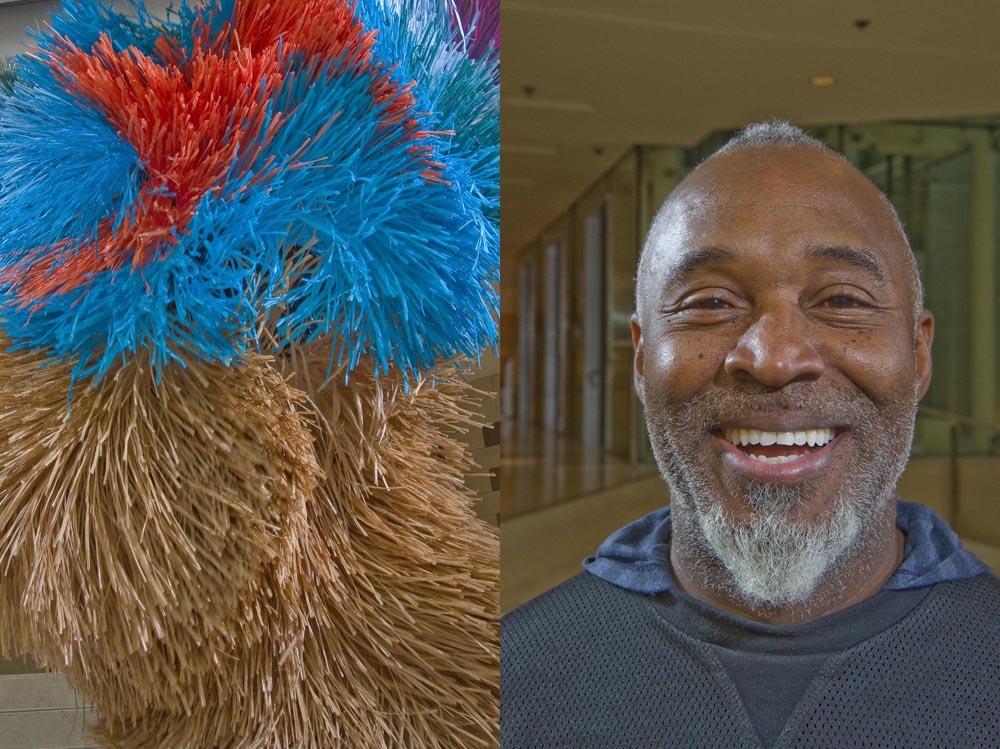
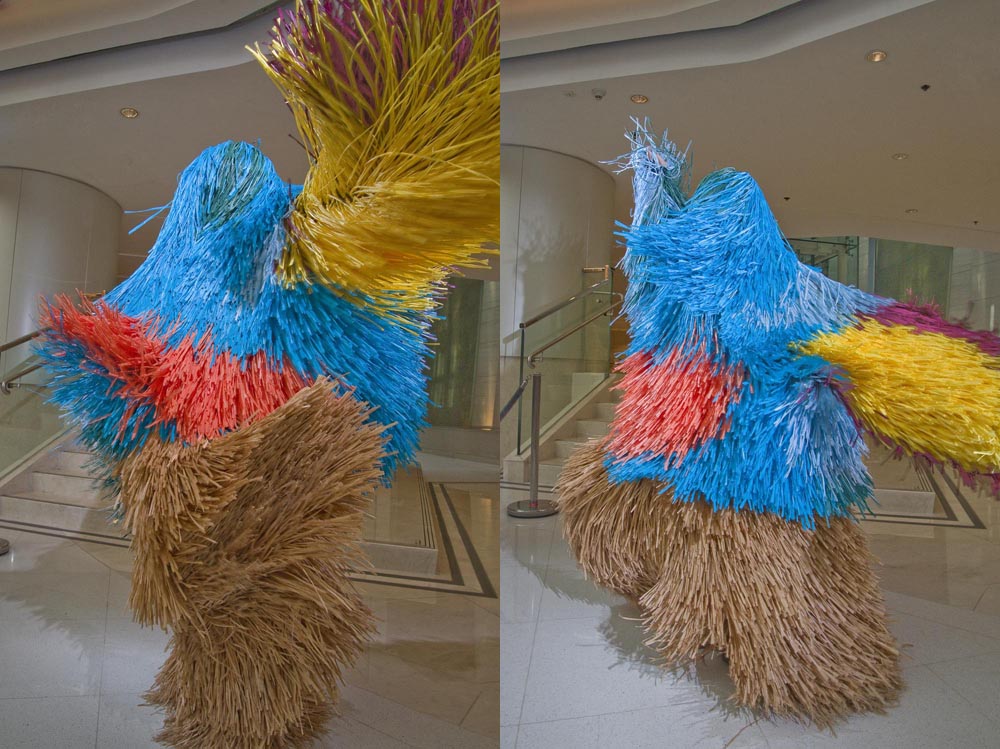
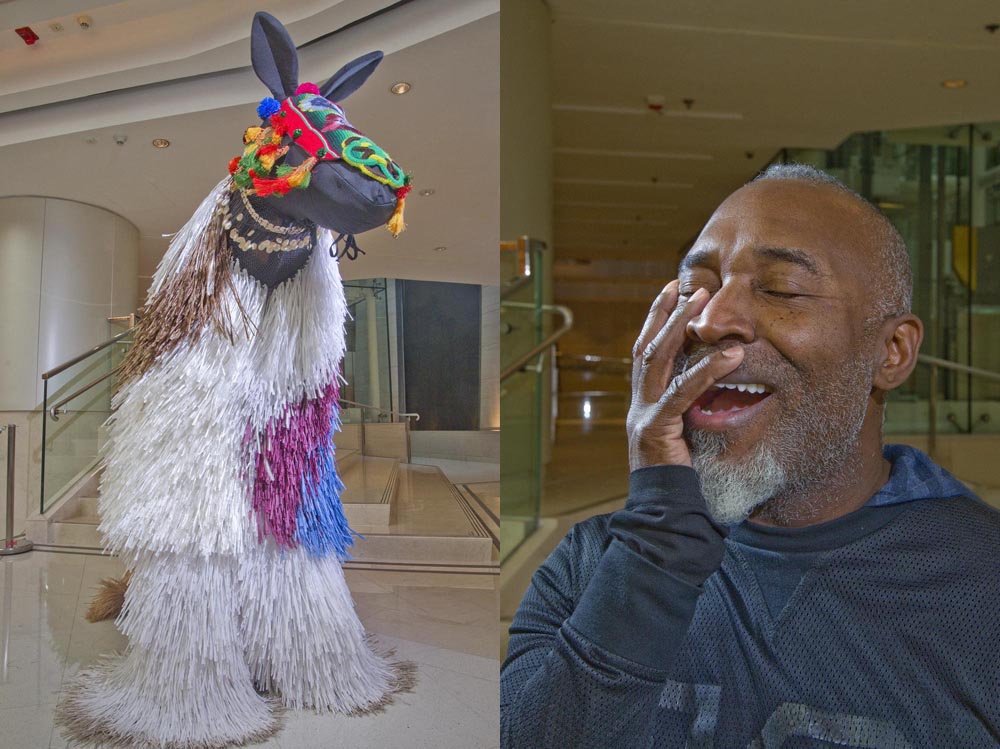
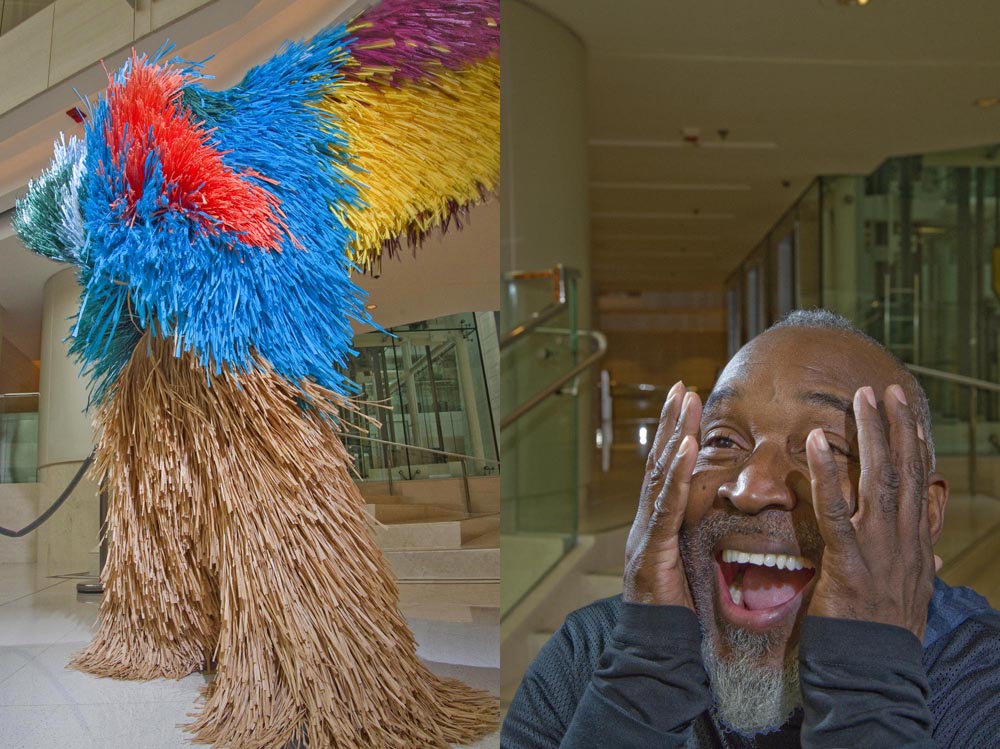
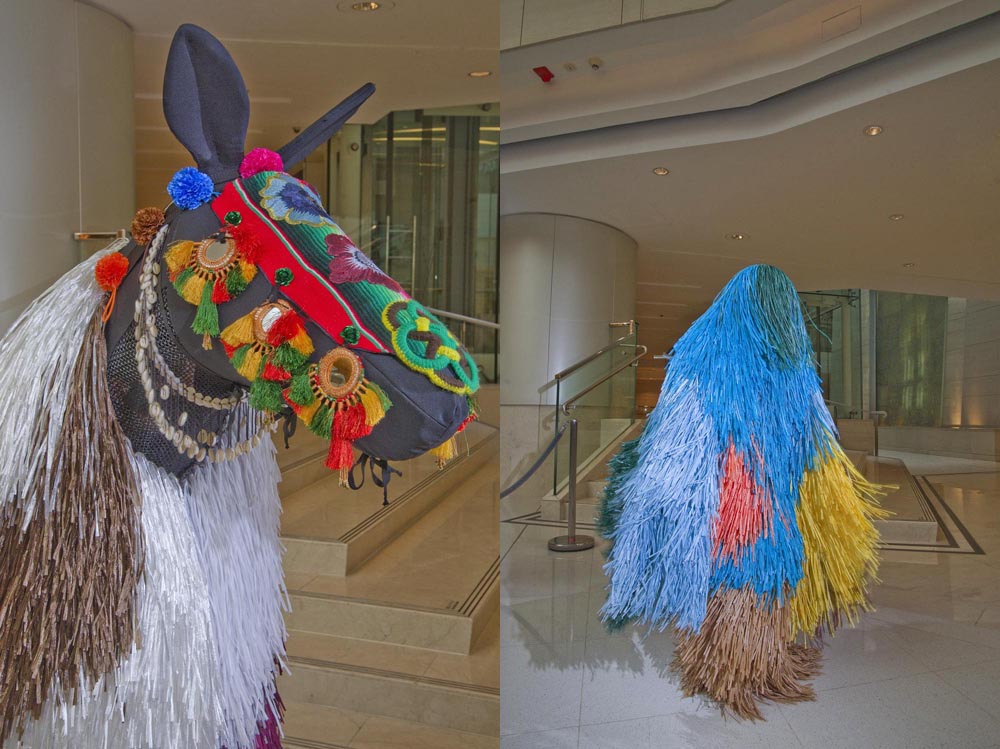
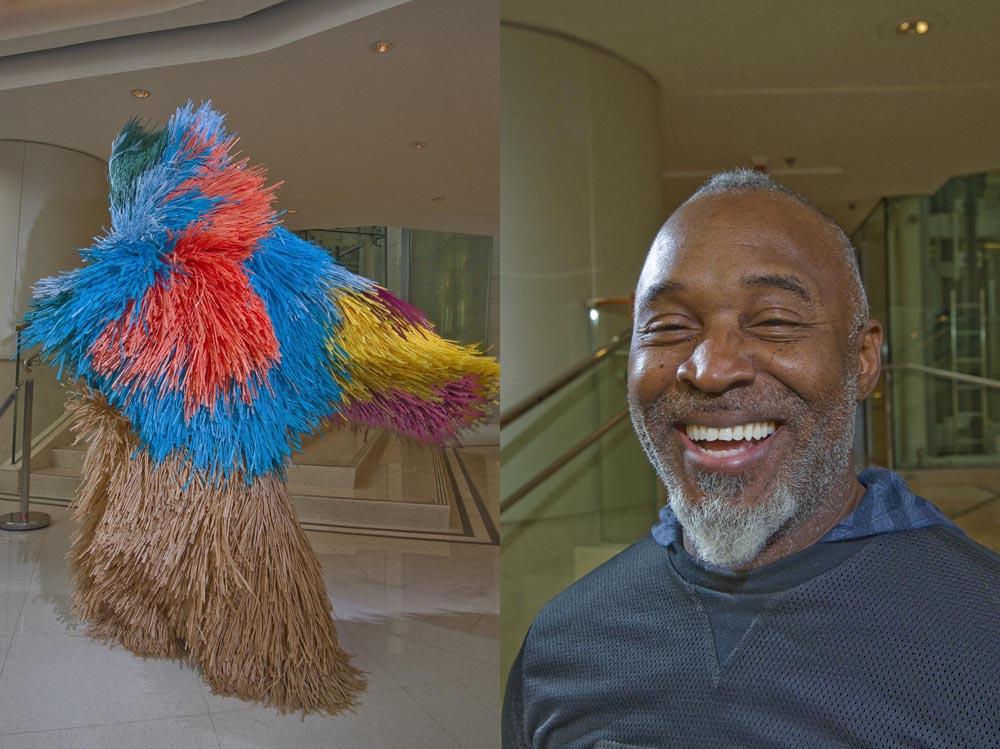



Speak Your Mind